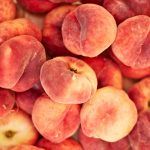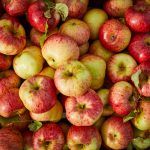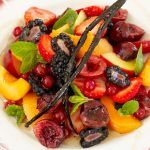Three weeks ago I cleared the tomatoes and the other fading summer crops from the polytunnel. They’ve been replaced with hardy salads for harvesting between now and spring. Two plants were granted a stay of execution but only because their handsomely striped heart-shaped fruits were still in the process of ripening. In its native South America this fruit is called pepino dulce – sweet cucumber – or even just pepino. Here, it seems that it’s being called a melon pear.
The flavour is pleasant and refreshing, falling somewhere between melon and cucumber. I am not sure whether I can discern a hint of pear in there too or not (I haven’t eaten many of these as yet). The pear in the name may instead refer to the fact that some specimens are shaped like pears rather than hearts or eggs. The flesh can be anything from greenish-white to yellowish-orange, depending on the cultivar. The skin is not eaten, however, as it is a bit tough and can sometimes have a slightly unpleasant aftertaste (reminiscent of turpentine, I thought). Don’t be put off by that though – if you enjoy growing new things give it a try. I have yet to experiment further than simply eating them fresh.

Despite comparisons with all these fruits, the pepino is related to none of them. Botanists have named it Solanum muricatum, which puts it in the same genus as both the aubergine and the potato. The fused petals of its purple-blue flowers are very like that of the potato and the leaves not that different either.
The pepino is best grown in a greenhouse border but in a large pot in a sunny conservatory or against a warm, sheltered wall outdoors would be worth a shot too. Though it is technically a perennial plant, in practice people usually grow it as an annual unless they’re lucky enough to have the facilities to overwinter it. I sow it in February when I do the tomatoes, pot it up as required in the same way and plant it out at the same time.
It is happy in most soils, provided that they drain well and are not over-rich. Regular watering is important, especially in hot weather, but waterlogging is to be avoided. Mulching is also beneficial. I have read that fruits will only set if night-time temperatures exceed 17ºC. I can well believe it – nothing appeared on these plants till partway through that warm spell in July. Fruit-set is also much better with two plants or more.

The plant is susceptible to the same pests as tomatoes and aubergines, namely aphids, whitefly and red-spider mite. I combat these with insecticidal soap and with biological controls (predatory invertebrates, sold by most organic seed suppliers). Since a long growing season is needed, any head start is welcome, so this year I took a few cuttings, complete with heel, in late summer. They took pretty easily and I shall try hard to get them through the winter. I’d really love Santa to bring me a heated greenhouse for Christmas.























